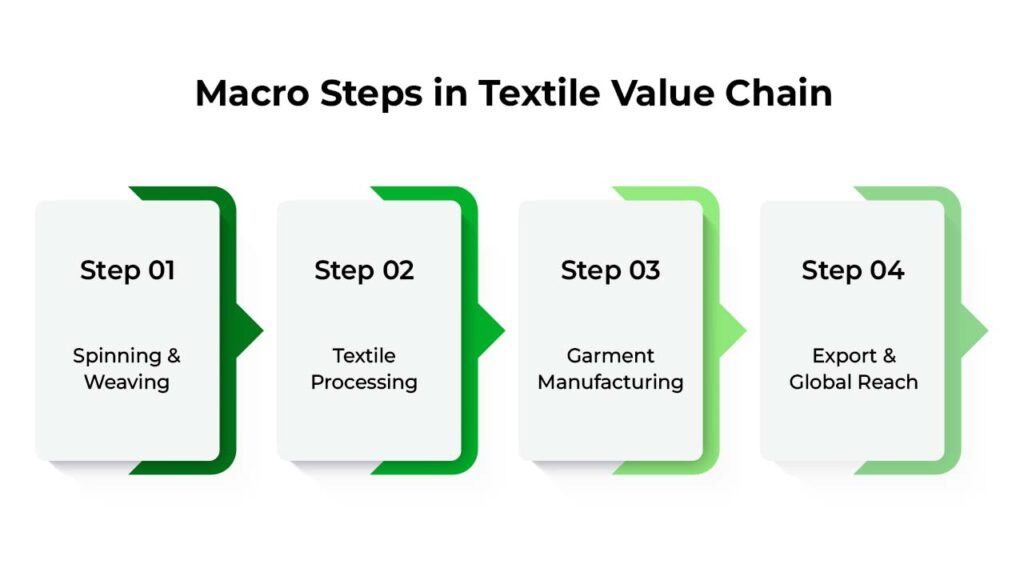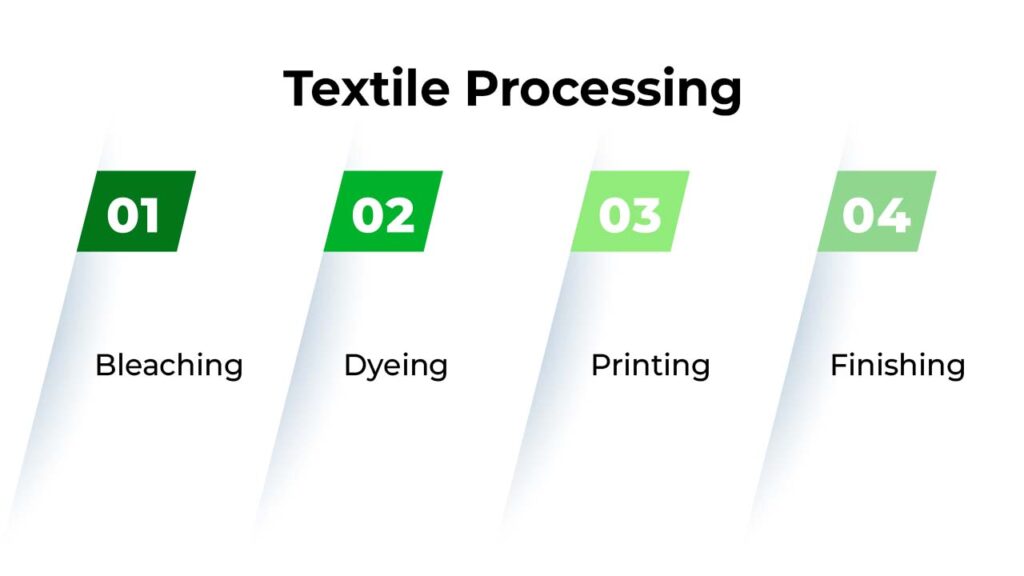Value Chain in Textile Industry of Pakistan
admin
June 13, 2023
Pakistan’s textile industry has developed into a thriving and dynamic sector essential to economic growth. Pakistan has established itself as a world leader in the production of textiles thanks to its long history and robust value chain. This article examines Pakistan’s complex textile value chain, revealing its complexities and outlining the elements contributing to its exceptional success.
The textile value chain includes several connected steps, from cotton cultivation to the production of finished clothing. With specialized actors collaborating to offer high-quality products to domestic and international markets, each stage is essential to the whole process. Especially in rural areas where cotton production is common, the industry has promoted employment prospects and economic growth.
The cultivation of cotton, the main raw material for the textile industry, has been boosted by Pakistan’s excellent agroclimatic conditions and improvements in agricultural methods. Cotton is converted into yarn and fabric throughout the spinning and weaving, demonstrating the industry’s dedication to efficiency and innovation. The quality and appearance of the fabric are further improved by textile processing, which uses bleaching, dyeing, printing, and finishing methods.
The value chain’s ultimate stage, where materials are turned into finished goods ready for consumption, is marked by the garment manufacturing industry. Due to its trained labor force, cheap pricing, and adherence to rigorous delivery dates, Pakistan is becoming a top choice for international brands looking for high-quality and reasonably priced clothing.
The textile industry’s export-focused strategy has greatly boosted Pakistan’s international reach. Pakistani textiles are known for their high quality, dependability, and great variety, and they sold in marketplaces worldwide. This global presence has widened opportunities for economic development, increased foreign exchange earnings, and improved trade ties.
Cotton Cultivation
Cotton cultivation forms the foundation of the textile value chain in Pakistan. Particularly in Punjab and Sindh, the country’s favorable agroclimatic conditions make it an ideal location for cotton cultivation. Cotton cultivation has a long history in Pakistan, with small producers and large landowners actively engaged in the industry.
Pakistan has adopted modern farming methods, hybrid seeds, and genetically modified varieties to ensure a steady supply of high-quality cotton. These developments have substantially increased productivity and enhanced the overall quality of cotton grown. Farmers have access to agricultural knowledge and resources, allowing them to maximize their yields and satisfy the textile industry’s rising demand.
Cotton cultivation entails several steps, including land preparation, sowing, irrigation, pest control, and harvesting. Depending on their operations’ size, farmers employ traditional and mechanized techniques. Larger farms use mechanized equipment to improve their efficacy, whereas smaller farms rely on manual labor. The promotion of cotton cultivation relies heavily on government initiatives and support. Farmers receive subsidies on inputs such as seedlings, fertilizers, and pesticides, ensuring their affordability and accessibility. In addition, research and development efforts concentrate on creating disease-resistant and high-yielding cotton varieties, thereby enhancing productivity.
Cotton cultivation contributes to the textile industry’s raw material supply and employment opportunities, especially in rural areas. It is an indispensable source of income for smallholder farmers, allowing them to enhance their standard of living and contribute to the local economy.

Spinning and weaving
Spinning and weaving are essential in the Pakistani textile value chain, where cotton is transformed into fibers and fabric. These operations are carried out in spinning mills, and weaving facilities outfitted with cutting-edge machinery and technologies.
Spinning is the process of transforming unprocessed cotton fibers into yarn. The cotton fibers are cleaned, carded, drawn, and twisted to create a continuous yarn thread. Numerous large and minor spinning mills in Pakistan contribute to the country’s yarn production. These mills generate various yarn types, including combed cotton, carded cotton, and blended yarns, to meet the needs of the textile industry.
The yarn is then transported to weaving facilities and transformed into fabric. Weaving is systematically interlacing yarns to produce a fabric’s structure. Pakistan is renowned for its proficiency in producing various fabrics, from simple weaving to intricate patterns and designs. The weaving facilities utilize modern looms and technologies to produce fabric with precision and efficiency.
Pakistan’s spinning and weaving industry prioritizes quality control and innovation. Continuous research and development efforts aim to improve the textile and fabric’s durability, uniformity, and appearance. Adopting advanced spinning techniques, such as ring spinning and open-end spinning, has improved textile quality and productivity. Similarly, the weaving industry has incorporated technological advancements such as air-jet and rapier looms to increase fabric quality and production speed.
Textile processing
Textile processing plays a vital role in the value chain in Textile Industry of Pakistan, where the fabric undergoes various treatments and enhancements to satisfy market demands. This stage entails various processes, including bleaching, dying, printing, and finishing, all of which aim to improve the fabric’s aesthetics and functional properties.
Pakistani textile processing facilities are outfitted with cutting-edge machinery and technologies to carry out these processes effectively. These facilities adhere to international quality standards and implement eco-friendly practices, ensuring the sustainability of their production. Let’s examine some of the most important textile processing procedures:
- Bleaching: Bleaching is a procedure that removes impurities, stains, and the fabric’s natural color, leaving behind a white or light-colored base. It enhances the fabric’s absorption capacity and prepares it for further processing.
- Dyeing: Dyeing is the process of adding color to the fabric. The textile processing facilities of Pakistan excel in dyeing techniques and offer a vast array of color options and dyeing methods. These units use conventional and modern dyeing techniques, such as vat dyeing, reactive dyeing, and digital printing, to produce vibrant and long-lasting colors.
- Printing: Printing imbues the fabric with decorative patterns or designs. Pakistan is renowned for its textile printing expertise, offering a variety of printing techniques, including screen printing, rotary printing, and digital printing. Combining traditional craftsmanship with modern technology, the industry creates intricate and aesthetically pleasing designs.
- Finishing: Fabrics endure finishing procedures to improve their properties and functionality. These may include mercerization, which enhances the fabric’s sheen and tensile strength, or treatments for moisture-wicking, anti-static, or flame-retardant properties. Additionally, finishing processes ensure the fabric’s durability, suppleness, and shrinkage resistance.
The textile processing industry in Pakistan places a heavy emphasis on quality control and sustainability. The units promote responsible chemical management, water conservation, and energy efficiency and conform to international environmental standards. This commitment to eco-friendly practices has positioned Pakistan’s textile industry as the preferred option for brands and consumers who are environmentally conscious.

Garment manufacturing
Fabrics are converted into ready-to-wear, consumer-ready garments during the manufacturing phase of Pakistan’s textile value chain. Pakistan has become a significant participant in the global garment manufacturing industry, attracting domestic and foreign brands.
Several significant variables contribute to the success of the country’s garment manufacturing industry. First, Pakistan has a large pool of skilled personnel with expertise in cutting, stitching, and quality control, among other aspects of garment production. The availability of qualified labor ensures that manufacturing processes are efficient and accurate.
Knitted and woven garments, household textiles, and industrial textiles are among the many products manufactured by Pakistan’s garment industry. The industry offers a variety of designs, styles, and sizes to satisfy the needs of various market segments. In addition, manufacturers can produce both small and large quantities to meet the requirements of various customers. Pakistan’s garment manufacturing industry has made paces in implementing sustainable practices in recent years. Numerous manufacturers are instituting eco-friendly initiatives, such as reducing water consumption, minimizing waste production, and employing eco-friendly dyes and chemicals. This commitment to sustainability correlates with the expanding global demand for ethical and sustainable fashion.
The ability of the industry to strike a balance between price, quality, and on-time delivery has made it the industry of choice for international brands seeking dependable manufacturing partners.
Export and global reach
Export and global reach are essential components of Pakistan’s textile industry, contributing considerably to its economy and establishing its position as a major player in the global market. The industry’s ability to export textiles has facilitated international trade, increased foreign currency revenues, and boosted economic growth.
Pakistan’s textiles have acquired international recognition for their quality, durability, and variety. The industry’s emphasis on innovation, technology adoption, and adherence to international quality standards has been instrumental in establishing its solid global reputation. The craftsmanship, attention to detail, and competitive pricing of Pakistani textiles make them highly desirable among international purchasers.
The Middle East, the United States, and the European Union are among Pakistani textiles’ most important export markets. These regions value the variety and quality of Pakistani textiles, such as garments, fabrics, household textiles, and industrial textiles. The industry’s success in diversifying its export markets has been aided by its capacity to serve various market segments and provide customized products.
The Pakistani government’s export-oriented policies and incentives have facilitated the industry’s global expansion. Such measures as duty drawbacks, tax exemptions, and export financing programs have encouraged textile manufacturers to increase their international trade. The government’s assistance and the industry’s dedication to meeting global standards have contributed to the establishment of long-term trade relationships with foreign customers.
Pakistan’s export success is also significantly influenced by its geographical location. Pakistan’s location at the crossroads of South Asia, Central Asia, and the Middle East places it near key markets. This proximity provides logistical benefits, lower transportation costs, and quicker access to international markets.
In addition, Pakistan’s robust diaspora communities have helped promote Pakistani textiles internationally. South Asian diaspora demand for traditional Pakistani garments such as shalwar kameez and sarees has generated a thriving niche market for the industry.
Conclusion
To summarize, Pakistan’s textile industry has a strong value chain, including cotton production, spinning and weaving, textile processing, and garment manufacturing. This sophisticated activity network has driven Pakistan’s textile sector to the forefront of the global market. The country’s good agroclimatic conditions, advances in farming techniques, and government assistance have all led to a consistent supply of high-quality cotton, the industry’s major raw material.
Pakistan’s textile sector is evolving, incorporating sustainable methods, technical improvements, and international standards. The sector’s tenacity, adaptability, and dedication to quality have made Pakistan a strong participant in the global textile industry.
To preserve its competitive advantage, Pakistan’s textile sector must continue to invest in R&D, sustainable practices, and trained workers. Pakistan’s textile sector is prepared for ongoing success and expansion in the next years by capitalizing on its strengths, embracing innovation, and cultivating strategic alliances.
Recent Posts
News
Blog
Have Any Question?
- +92 51 2726971
- info@ptc.org.pk
